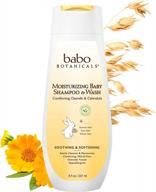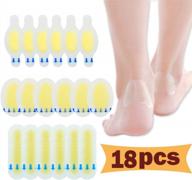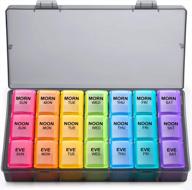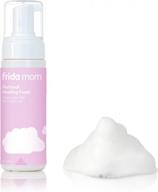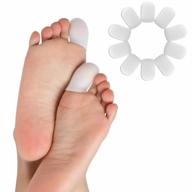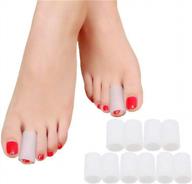Curing Common Foot Problems
Our feet carry us everywhere throughout the day, so it's no wonder they can develop some issues. Fortunately, there are ways to cure many common foot problems. With a bit of care and some helpful remedies, you can get your feet feeling comfortable again.
Another interesting products


34 Review

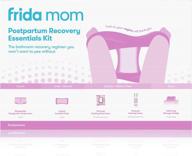

28 Review

Athlete's Foot
Athlete's foot is a fungal infection that causes itching, burning, and peeling. It thrives in warm, moist environments like sweaty shoes and locker room showers. To treat it:
- Apply over-the-counter antifungal creams, sprays, or powders daily.
- Keep feet dry and wear moisture-wicking socks.
- Disinfect shoes and socks to kill fungus.
- Soak feet in a 50/50 mixture of vinegar and water.
- Use tea tree oil, which has natural antifungal properties.
Top products in 🦶 Foot Health
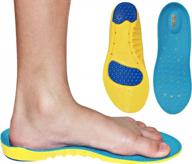

35 Review

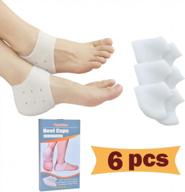

36 Review

Plantar Fasciitis
Plantar fasciitis causes stabbing heel pain, especially first thing in the morning. To reduce inflammation:
- Stretch calves and feet before getting out of bed.
- Apply ice packs for 15 minutes several times per day.
- Wear shoes with good arch support.
- Try over-the-counter arch supports or orthotic inserts.
- Take anti-inflammatory medications like ibuprofen.
Similar products
Bunions
| Conservative Treatments | When to Seek Surgery |
|---|---|
|
|
Corns and Calluses
Corns and calluses result from friction and pressure. To remove them:
- Soak feet in warm water to soften.
- Gently rub with a pumice stone.
- Apply medicated patches containing salicylic acid.
- Don't cut corns/calluses with razors or knives.
- Wear properly fitting footwear to prevent recurrence.
Ingrown Toenails
Ingrown toenails are painful. To get relief:
- Soak feet in warm water with Epsom salts.
- Trim nails straight across to prevent digging into skin.
- Use cotton under the corner of the nail to lift it.
- Apply antibiotic cream to prevent infection.
- Severe cases may require minor surgery to fully remove part of the nail.
Don't let foot problems slow you down. With some simple at-home treatments, you can get your feet feeling comfortable again.
Plantar Fasciitis
Plantar fasciitis is one of the most common causes of heel pain. It involves inflammation of the plantar fascia - the thick band of tissue that runs across the bottom of your foot.
Symptoms
The classic symptom of plantar fasciitis is stabbing pain in the bottom of the heel that is worse first thing in the morning when getting out of bed. Other symptoms include:
- Pain that worsens with long periods of standing or walking
- Pain after getting up from sitting for awhile
- Heel pain and stiffness after periods of rest
- Tenderness and pain when pressure is applied to the plantar fascia
Causes
Plantar fasciitis often results from repetitive small tears and inflammation of the plantar fascia. Common causes include:
- Excessive foot pronation (rolling inwards)
- Tight calf muscles
- Weak foot muscles
- Excess weight and obesity
- Poorly fitting or worn out shoes
- High impact exercise (like running)
For example, my neighbor Jane developed plantar fasciitis after gaining 40 pounds over the past two years and spending long days on her feet as a cashier.
Treatment
There are many conservative treatment options for plantar fasciitis. These include:
- Rest - Avoid activities that worsen pain.
- Ice - Apply ice packs to the bottom of the foot for 15 minutes several times per day.
- Stretching - Stretch the plantar fascia and Achilles tendon, especially before getting out of bed.
- Night splints - Wearing splints at night keeps the fascia stretched while sleeping.
- Arch supports - Supportive insoles redistribute pressure and reduce strain on the plantar fascia.
- NSAIDs - Anti-inflammatory medications like ibuprofen can relieve pain.
- Physical therapy - Exercises can strengthen the foot and improve flexibility.
Most cases of plantar fasciitis will resolve with these conservative treatments over a period of several months.
When to See a Doctor
See your doctor if self-care strategies are not helping within a few months. Other potential treatments include:
- Corticosteroid injections
- Custom orthotics
- Night splints
- Casting or walking boots
- Shockwave therapy
- Surgery (in rare cases)
With proper treatment, most cases of plantar fasciitis will heal within 6 to 18 months. Seeking care can help get you back on your feet free of pain.
Let your doctor know if heel pain persists longer than expected - an accurate diagnosis is key to successful treatment.
Corns and Calluses
Corns and calluses are areas of thick, hardened skin that develop on the feet due to friction and pressure. They can become painful if left untreated.
Causes
Corns and calluses typically develop on areas like:
- Toes
- Balls of the feet
- Heels
- Sides of the feet
Common causes include:
- Ill-fitting shoes that rub against the feet
- High heels
- Excessive sweating of the feet
- Abnormalities in foot structure
- Repeated pressure on part of the foot
For example, my friend Susan developed a callus on the ball of her foot from running long distances in shoes that were too tight.
Treatment
Treating corns and calluses at home involves:
- Soaking - Soak your feet in warm water to soften the skin.
- Exfoliating - Gently rub the areas with a pumice stone or foot file.
- Medications - Over-the-counter corn/callus remover products can help.
- Padding - Use moleskin, gel pads or orthotics to reduce friction.
- Better Footwear - Wear properly fitted shoes that don't rub your feet.
It's important to treat corns and calluses gently. Don't cut them with razors or knives which can lead to infection.
Seeing a Doctor
See your podiatrist if:
- Home treatments aren't working
- Corns/calluses are very painful or debilitating
- They are infected (red, swelling, pus)
- You have diabetes or circulation issues
A podiatrist can safely pare down thick calluses. They may also recommend prescription strength topical medications, custom orthotics, or other advanced treatments to prevent corns and calluses from returning.
Ingrown Toenails
An ingrown toenail occurs when the edge of the nail grows into the surrounding skin, leading to pain, redness, swelling, and infection.
Causes
Ingrown toenails often happen when:
- Toenails are cut too short
- Toenails are rounded off at the edges (should cut straight across)
- Pressure from shoes pushes the nail into the skin
- Trauma injures the nail bed
- Thickening of the nail makes it dig into the skin
For example, my son developed an ingrown toenail after stubbing his toe playing soccer. The trauma caused the nail to become thicker and start growing into his skin.
Symptoms
Signs of an ingrown toenail include:
- Pain, redness, swelling around the toe
- Pus drainage from the nail
- Difficulty walking
- Sensitive, painful nail when pressure applied
Treatment
Home treatment involves:
- Soaking - Soak the foot in warm water with Epsom salts to relieve swelling.
- Lifting the nail - Place cotton under the nail corner to lift and separate it from the skin.
- Trimming - Carefully trim the nail straight across to help relieve pressure.
- Antibiotics - Apply antibiotic cream if area is red or infected.
Seeking Medical Care
See your doctor if:
- Home treatment doesn't relieve pain and swelling
- The ingrown nail causes a visible infection
- This is a reoccurring problem
For severe or recurrent cases, a podiatrist may surgically remove part or all of the toenail. This prevents it from growing back into the skin.
Prompt treatment helps avoid complications like infection spreading. Be gentle with ingrown toenails and let a doctor know if problems persist.
Keeping Children's Feet Healthy
As a parent, keeping your child’s feet healthy is an important part of their overall wellbeing. Here are some tips to help promote proper foot care and prevent issues in children:
Proper Footwear
- Have your child's feet measured regularly as they grow to ensure proper fit.
- Choose shoes with rubber soles and roomy toe boxes to avoid cramping their toes.
- Avoid hand-me-down shoes which may not fit right.
- For outdoor play, select sturdy shoes with good traction that provide ankle support.
- Alternate shoe styles day-to-day to reduce repetitive pressure on feet.
Daily Foot Hygiene
- Teach your child to wash their feet daily with soap and water, drying between the toes.
- Trim toenails regularly so they don’t become ingrown.
- Moisturize feet daily if they are prone to dry, cracked skin.
- Change socks daily to avoid fungal infections like athlete’s foot.
Preventing Injury
- Make sure kids wear shoes when playing outside to avoid cuts and puncture wounds.
- Don’t allow barefoot jumping on hard surfaces that can bruise heels.
- Use protective foot gear for sports like soccer or basketball.
- Stretch before physical activity to warm up feet and prevent strains.
Treating Issues Early
- Inspect child’s feet regularly for blisters, warts, ingrown nails.
- Disinfect and bandage minor cuts promptly to avoid infection.
- Apply ice immediately to reduce swelling of sprains/strains.
- Make a doctor’s appointment at first sign of persistent pain or dysfunction.
Establishing good foot care habits early promotes your child’s comfort and mobility long-term. Consult a pediatrician if you have any concerns about your child’s foot health.
What is the Benefit of Amazon Prime When Buying Foot Health Products?
Amazon Prime provides a number of benefits when shopping for foot health items like orthotics, creams, braces, massagers and more. Here are some of the top perks:
Free Two-Day Shipping
One of the biggest advantages of Prime is free two-day shipping on most items. This allows you to quickly get foot health products delivered right to your door at no extra cost. No minimum order value is required to qualify for the two-day shipping perk.
Free One-Day and Same-Day Delivery
For Prime members in certain ZIP codes, one-day and same-day delivery options are also available when buying eligible foot care items. This is extremely convenient when you need something urgently like an orthotic insert to help alleviate foot pain.
Free Release-Date Delivery
When pre-ordering upcoming foot health products, Prime members can get free release-date delivery so the item arrives on the exact day it hits the market. This ensures you get new braces, massagers, etc. as soon as they are available.
Try Before You Buy
Prime has an extensive try before you buy selection so you can try on footwear, test out orthotics and more for a week before purchasing. This helps you find the perfect item before committing.
Easy Returns
Prime makes returns quick and convenient. If a foot health product doesn't work out for you, returns and refunds are hassle-free. Items can be returned within 30 days of receipt for a full refund.
Overall, a Prime membership provides the convenience, fast shipping, and ease of returns needed when ordering foot care supplies. The program can save you time and money.
What Are The Most Common Foot Problems In Babies And Children??
Common foot problems in babies and children include deformities and other conditions that affect the legs and feet. Some of the most common foot problems in newborns are metatarsus adductus and calcaneovalgus, which are usually caused by how the baby's foot was positioned and molded inside their mother. These conditions usually improve on their own without any treatment and don't cause any long-term problems. Clubfoot and congenital vertical talus are serious congenital disorders that need prompt treatment by an experienced clinician. Other common foot problems in children include in-toeing, out-toeing, flat feet, tiptoe walking, heel pain, Sever's disease, ingrown toenails, fungal nail infections, plantar warts, and overlapping toes. Most minor foot problems in children correct themselves, but it's important to seek professional assistance if your child is experiencing foot pain. Early detection of foot problems in infants allows timely corrective treatment, if required.
What Are The Causes Of Metatarsus Adductus And Calcaneovalgus In Newborns??
Metatarsus adductus and calcaneovalgus are two common foot deformities in newborns. These conditions are caused by how the baby's foot was positioned and molded inside their mother. The exact cause of these deformities is not known, but some factors that may contribute to them include the baby's position in the womb, the amount of amniotic fluid, and genetics. Metatarsus adductus is a curve in the middle of the foot that occurs when the feet are folded inward. Calcaneovalgus is a positional deformity that is characterized by the foot being positioned in extreme hyperextension, with its dorsum frequently touching the distal leg. Females are affected more often than males, and this deformity can be unilateral or bilateral. Metatarsus adductus and calcaneovalgus usually improve on their own without any treatment, and don't cause any long-term problems. However, if the deformities are severe, they may require corrective shoes or splints, and in exceptional instances, surgery may be required.
Learn More
When communicating with others, it's important to provide enough context information to ensure that the other person understands what you're asking for. Here are some tips on how to provide context when asking for information or updates:
- Begin with a polite greeting and closing to show respect and professionalism.
- Provide enough context information to help the other person understand what you're asking for.
- Be specific about what you need and why you need it.
- Avoid using demanding or forceful language, and instead use polite language to make your request.
- If you're asking for clarification, use "Could you please clarify?" instead of "Explain."
- If you're providing information, make sure to give enough context to help the other person understand the nuances.
- Remember that context is all the information that you need to interpret what you've found, so be sure to provide enough information to help the other person understand what you're asking for.





